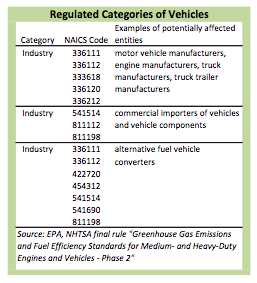Deliver Mix in Well-Regulated Trucks, Trailers
BY Sandy Lender

Equipment fleet owners who deliver asphalt mix will be interested in the final ruling from the Environmental Protection Agency (EPA) and the Department of Transportation’s National Highway Traffic Safety Administration (NHTSA). The agencies submitted for publication in the Federal Register Aug. 16, 2016, the Greenhouse Gas Emissions and Fuel Efficiency Standards for Medium- and Heavy-Duty Engines and Vehicles – Phase 2. The ruling directly affects the manufacturers of medium-duty vehicles (MDVs) and heavy-duty vehicles (HDVs), and that means the end user can expect some changes down the road. By the 2027 deadline, to be exact. The submitted publication states the Phase 2 standards will be phased in through model year 2027 (MY 2027).
“The terminal requirements go into effect in 2027, and would apply to MY 2027 and subsequent model year vehicles, unless modified by future rulemaking. The Phase 2 standards will maintain the underlying regulatory structure developed in the Phase 1 program, such as the general categorization of MDVs and HDVs and the separate standards for vehicles and engines.”
Notice that the document mentions categorization. A portion of the final ruling focuses on categorizing the engines and vehicles to be modified, upgraded, freed of leaks, etc. (See Table 1.)
“The heavy-duty category incorporates all motor vehicles with a gross vehicle weight rating of 8,500 lbs. or greater, and the engines that power them, except for medium-duty passenger vehicles already covered by the greenhouse gas standards and corporate average fuel economy standards issued for light-duty model year 2017-2025 vehicles.”
The final ruling puts specialized vocational vehicles, such as the dump trucks used in the asphalt industry, in one of three subcategories based on engine classification. Specialized vocational vehicles only represent “approximately 17 percent of the fuel consumption and GHG emissions from MDVs and HDVs,” according to the final ruling, but that’s enough to put them squarely in the Phase 1 program for NHTSA fuel efficiency standards, which covered all new trucks and heavy vehicles in model years 2014 and later. Heavy-duty engines get their own independent standards from the Phase 1 rule. According to the EPA/NHTSA document, “The Phase 1 standards were premised on utilization of technologies that were already in production on some vehicles at the time of the Phase 1 FRM and are adaptable to the broader fleet. The Phase 1 program provides flexibilities that facilitate compliance….The Phase 1 program was projected to save 530 million barrels of oil and avoid 270 million metric tons of GHG emissions. At the same time, the program was projected to produce $50 billion in fuel savings and $49 billion of net societal benefits.”

Table 1. Regulated Categories of Vehicles
That leads industry and the marketplace to Phase 2.
“The Phase 2 standards will maintain the underlying regulatory structure developed in the Phase 1 program, such as the general categorization of MDVs and HDVs and the separate standards for vehicles and engines. However, the Phase 2 program will build on and advance Phase 1 in a number of important ways including the following: basing standards not only on currently available technologies but also on utilization of technologies now under development or not yet widely deployed while providing significant lead time to assure adequate time to develop, test, and phase in these controls; developing first-time GHG and fuel efficiency standards for trailers; further encouraging innovation and providing flexibility; including vehicles produced by small business manufacturers with appropriate flexibilities for these companies; incorporating enhanced test procedures that (among other things) allow individual drivetrain and powertrain performance to be reflected in the vehicle certification process; and using an expanded and improved compliance simulation model.”
Among the aspects of regulation going into effect with Phase 2 is something new for the industry. The ruling is setting standards for trailers for the first time.
“In addition to retaining the vehicle and engine categories covered in the Phase I program, the Phase 2 standards include fuel efficiency and GHG emission standards for trailers used in combination with tractors. Although the agencies are not finalizing standards for all trailer types, the majority of new trailers will be covered.”
Phase 2 will also “strengthen” standards. That means researchers can build upon advances in technology as tractor and trailer models are phased in. Phase 2 will encourage advances in technology, giving research and development room to combine a menu of improvements. An example reads this way: “[D]ifferent combinations of improvements like advanced aerodynamics, engine improvements and waste-heat recovery, automated transmission, lower rolling resistance tires, and automatic tire inflation can be used to meet standards.” Phase 2 also takes financial hardship for small businesses into account, exempting them from Phase 1 standards and providing simplified certification requirements to leap into Phase 2.
